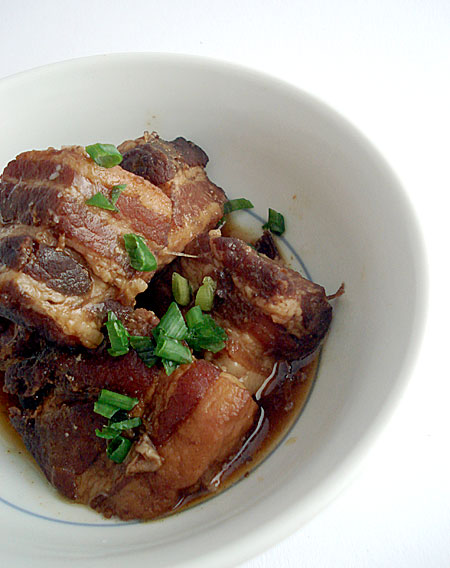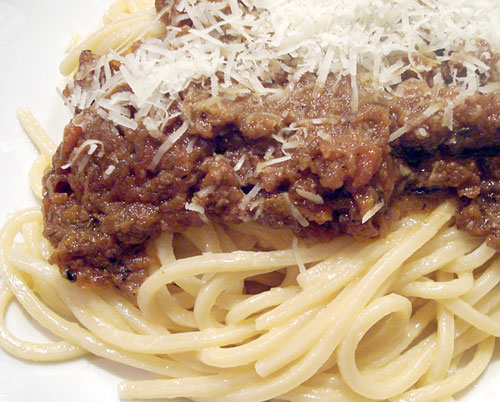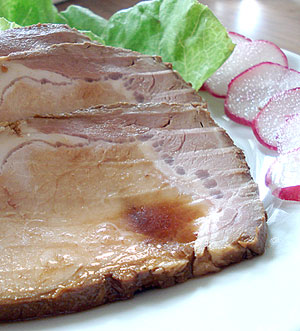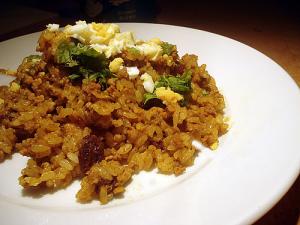
Today is my mother's birthday. In her honor, here is one of the few meat dishes that she still allows in her diet: braised pork belly, or buta no kakuni. It's amazing that she will still eat this, because basically pork belly is bacon without the smoke or salt cure. And in buta no kakuni the bacon, I mean belly, comes in big chunks of layers of meat and unctuous pork fat.
Pork belly recipes exist in other cuisines, especially around northern Europe, but I can't really stand most of them, even if people in Germany and Britain rave about roasted pork belly with crackling. (The crackling part is ok, but the meat part...I don't know.) I like fat in moderation as much as anyone, but that amount of gelatinous pork fat is rather hard to bear. That is unless it's been slowly braised in a salty-sweet liquid for hours and hours, until both the fat and the meat melt in your mouth.
Very similar recipes exist in Chinese (from Peking-style especially) cuisine, and a great Okinawa speciality is _rafute_. This is a bit like rafute but has a bit more spice and things in it, so it's closer to the Peking style I think. Either way it's a great treat once in a great while. It's definitely a cold weather dish.
Filed under:
japanese winter slowcook pork meat

I love pasta in many guises, but when it comes to ultimate Comfort Pasta, there is nothing that compares to a spaghetti bolognese. By spaghetti bolognese, I mean spaghetti topped with a rich, ground-meat and tomato based sauce. No fancy ragu or such. I don't think it's that authentically Italian, but I don't really care. It's one of my favorite cool-weather dinners.
Once upon a time, I had what I thought was a perfect recipe for spaghetti bolognese. Then, about a year ago I lost my way. After a year of bewilderingly off-target bolognese, I've found my way back.
I blame Heston Blumenthal for messing with my head. (Disclaimer: I am otherwise a big fan of Mr. Blumenthal.) Last year, he tackled spaghetti bolognese on his In Search of Perfection television series (and in the book of course), and came up with a "perfect" version. The perfect Blumenthal version of spaghetti bolognese is, naturally, extremely complicated, but compared to the other "perfect" versions of various popular dishes it seemed to be the most doable. So, we (note the plural: it required a team effort) tackled it, piece by piece. It does help in life to have an almost equally food-obsessive partner for such quests.
It took us 3 full days to accomplish, starting from the pre-ordering of the meaty oxtails at the butcher counter (it's not a commonly used cut here), finding the perfect spaghetti, ripe tomatoes in December (yes, I know) and the final slow cooking of the sauce. And the result?
It was good, yes, but perfect? Neither of us was sure. But yet it had flashes of something great in there; the meatiness of the gelatinous oxtail, the unctuous richness. So, we embarked on a long journey of trying to tweak that recipe. We tried different meat combinations. (Turkey is a definite no.) We experimented with bacon, chorizo, various sausages, salami. We tried less or more of the vegetables, canned tomatoes alone or fresh alone.
All were interesting, but I still felt off kilter. Then, the other day I made bolognese more or the way I had made it for years until the Blumenthal experiments - and, it was just about perfect.
Mind you, it's probably because my criteria for a perfect bolognese are different from the great chef's, as I explain below. And some of the ideas gleaned from the Blumenthal version and the ensuing experiments did creep in, making the sauce even better. In any case, I'm now happy that this is my Perfect Spaghetti Bolognese. I can now move on to perfecting other things.
Filed under:
dinner winter sauce pasta favorites italian meat

With summer just around the corner, I like to think of food that can be made well ahead and tastes great served cold, or at least cool, to keep me out of a hot kitchen. The vegetable part of this is usually taken care of with seasonal vegetable salads and the like. If the protein part means meat, I like to have pre-cooked pieces tucked away in the freezer.
One of my favorite cold meats is poached and marinated pork, or nibuta. (Ni means to cook in liquid, and buta is pig.) It's very easy to make, stores beautifully in the refrigerator for about a week or much longer in the freezer, and of course, tastes great - savory, slightly sweet, and very juicy. It can be sliced very thinly or julienned for one-dish meal salads or in sandwiches, or chopped up and added to stir-fries, wraps, and so on. It's a great addition to a bento box. It can be cubed or coarsely ground and used instead of char siu (roast pork) in steamed buns or bao. The possibilities are only limited by your imagination.
There's one unusual 'secret ingredient' in the poaching liquid, umeboshi or pickled plum. You can omit this if you like, but adding just one umeboshi seems to de-fat the meat a bit more than just poaching, plus making it taste a bit cleaner and fresher in an interesting way.
Filed under:
basics japanese weekend project summer pork meat
In the fourth and final episode of Kill It, Cook It, Eat It, they reviewed and summarized the previous 3 episodes, visited a small poultry 'processing' plant, and showed how a pig is butchered in the traditional way - no stun guns - in Spain.
(Warning: potentially disturbing details follow)
Filed under:
books and media tv ethics education chicken meat
Last night I finally watched the third episode of Kill It, Cook It, Eat It, as it aired instead of recording it for later viewing, fast-forward button at the ready. (My reviews of Part 1 and Part 2.) In this episode, it was the turn of pigs to be slaughtered. (Warning: some gory details follow...warning put here since a reader complained about a previous entry. When animals get slaughtered, it is gory.)
Filed under:
books and media tv ethics education pork meat
I've just watched the second episode of Kill It, Cook It, Eat It. If anything it was more intense than the first. I just couldn't watch it live, just in case I needed to fast-forward some spots, so I recorded it on my DVR and watched it a bit later. As it happens I didn't fast forward anything, though I was very tempted to at times. I made myself sit still and watch.
Filed under:
books and media tv ethics education meat
Last night the first episode of a TV series called Kill It, Cook It, Eat It aired on BBC Three. The premise of the program(me) is to show exactly how meat gets to our plates.
The first episode jumped right in, by showing, in an actual working abattoir, the slaughter and butchering of real live cows. This was witnessed by several members of the public through glass windows in a special observation area built around the abatoir. Later on, the same people ate meat cut from the cows they had just witnessed being slaughtered and prepared on the spot by a chef.
Filed under:
books and media tv ethics education meat
Frank Bruni gives the steakhouse at the Penthouse Executive Club a pretty entertaining one star review. "Hmm, where have I heard of this place before" I thought, and rummaged through my stacks of recorded food shows. Ah, celebrated don't-call-it-molecular-gastronomy chef Heston Blumenthal paid it a special visit on his TV show last year, to show his drooling mostly British viewers er, great looking meat. I mean the aged sides of beef, of course.
Filed under:
restaurants chefs meat newyork

While the standard curry dish in Japan is a kind of curry stew served on plain rice, dry curry, which is a sort of fried rice with curry flavor, is almost as popular. And unlike the stew-type of Curry Rice it's very fast and easy to put together.
What makes it Japanese really is the use of _japonica_ (medium-grain) rice. Dry curry made with Japanese rice makes a great obento lunch, tasty at room temperature or warmed up in the microwave. The stick-together moist quality of the rice keeps it edible where a dryer stay-apart rice like basmati might taste too dry. Dry curry also has the mixture of sweet and savory, which appears quite a lot in Japanese food, especially the kind that comes from the Kanto (Tokyo-area) region where my family is from.
Filed under:
japanese rice yohshoku ground meat curry meat
Pages